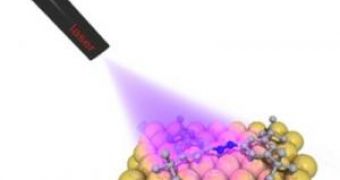A new discovery in the field of nanotechnology could produce the smallest machines in history. The best part is that scientists will be able to remotely control them using rays of UV light, due to their shapeshifting properties.
Physicists at the University of California at Berkeley presented the latest discovery in the nanoworld, a new method of controlling a layer of molecules using nothing but ultraviolet light. Their discovery is based on the shapeshifting properties of tiny molecules of azobenzene, which adhere to a layer of pure gold when an ultraviolet laser is projected on them.
This means that these molecules could one day be incorporated into various applications, like nanomachines, where they could act as remotely controlled nanoscopic switches triggered by UV light, or as pistons and other moving parts of the smallest molecular engines of the future.
Azobenzene is a chemical compound that has been studied more intensively in the past years due to its extraordinary ability to absorb light. It comes in two isomeric forms: a long-form and short-form.
Upon exposure to UV light and visible light alternatively, the long-form is converted into the short-form and exposure to visible light transforms it into the long-form again, this increase-decrease in length producing a molecular motion, like natural muscle tissue.
Until now, this movement has only been produced when azobenzene molecules were suspended in liquids or incorporated into plastics, both of them being rather useless basis for complex nanomachines.
The team solved this problem by adding legs made of carbon and hydrogen atoms to molecules mounted on a gold surface, which allows them to keep a small distance from the metal itself. These anchoring legs may provide only a less than a billionth of a meter of clearance, but this seems to be enough to let the move in response to the UV illumination.
The fact that the shape of the molecules can easily switch between two configurations is making the scientists confident that they will be able to incorporate their findings in future nanoscale machinery.

 14 DAY TRIAL //
14 DAY TRIAL //